Wavelet analysis. The basics
- Tutorial
Introduction
The English word wavelet (from the French "ondelette") literally translates as "short (small) wave." In various translations of foreign articles into Russian, there are also terms: “burst”, “burst function”, “low-wave function”, “wave”, etc.
Wavelet transform (VP) is widely used for signal analysis. In addition, it finds great application in the field of data compression. The VP of a one-dimensional signal is its representation in the form of a generalized series or Fourier integral over a system of basis functions.
constructed from the mother (source) wavelet
Factor
An example is the Mexican hat wavelet in the time and frequency domains:
Wavelet listing for time domain
from numpy import*
import matplotlib.pyplot as plt
x= arange(-4,30,0.01)
def w(a,b,t):
f =(1/a**0.5)*exp(-0.5*((t-b)/a)**2)* (((t-b)/a)**2-1)
return f
plt.title("Вейвлет «Мексиканская шляпа»:\n$1/\sqrt{a}*exp(-0,5*t^{2}/a^{2})*(t^{2}-1)$")
y=[w(1,12,t) for t in x]
plt.plot(x,y,label="$\psi(t)$ a=1,b=12")
y=[w(2,12,t) for t in x]
plt.plot(x,y,label="$\psi_{ab}(t)$ a=2 b=12")
y=[w(4,12,t) for t in x]
plt.plot(x,y,label="$\psi_{ab}(t)$ a=4 b=12")
plt.legend(loc='best')
plt.grid(True)
plt.show()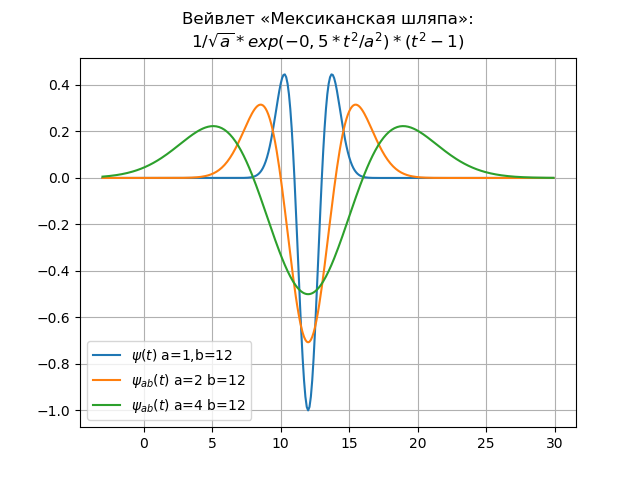
Listing for the wavelet spectrum
from numpy import*
from pylab import *
from scipy import *
import os
def w(a,b,t):
f =(1/a**0.5)*exp(-0.5*((t-b)/a)**2)* (((t-b)/a)**2-1)
return f
x= arange(-4,30,0.2)
def plotSpectrum(y,Fs):
n = len(y)
k = arange(n)
T = n/Fs
frq = k/T
frq = frq[range(int(n/2))]
Y = fft(y)/n
Y = Y[range(int(n/2))]
return Y,frq
xlabel('f (Hz)')
ylabel('|Y(f)|')
Fs=1024.0
y=[w(1,12,t) for t in x]
Y,frq=plotSpectrum(y,Fs)
plot(frq,abs(Y),label="$\psi(\omega)$ a=1,b=12")
y=[w(2,12,t) for t in x]
Y,frq=plotSpectrum(y,Fs)
plot(frq,abs(Y),label="$\psi_{ab}(\omega)$ a=2 b=12")
y=[w(4,12,t) for t in x]
Y,frq=plotSpectrum(y,Fs)
plot(frq,abs(Y),label="$\psi_{ab}(\omega)$ a=4 b=12")
plt.title("Вейвлет «Мексиканская шляпа» частотная область $\omega$")
legend(loc='best')
grid(True)
show()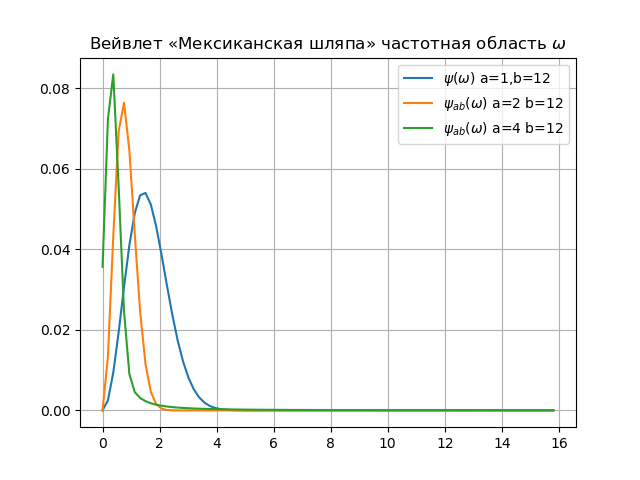
Conclusion:
1. There is indeed a relationship between the concept of Fourier harmonics and the scale of the wavelet. The main thing in this relationship is the inverse proportion of the natural frequency and scale. In addition, reducing the scale, we increase the bandwidth of the wavelet spectrum.
2. By changing the scale (increasing a leads to a narrowing of the Fourier spectrum of the function
3. The above listings written in the freely distributed high-level Python language allow you to select functions for wavelets that meet the specified requirements. However, it is additionally necessary to take into account all the main signs of wavelets.
The main signs of the wavelet
Limitedness. The square of the norm of the function must be finite:
Localization. VP, in contrast to the Fourier transform, uses a localized initial function both in time and in frequency. To do this, it is enough that the following conditions are met:
For example, a delta function
Zero average. The graph of the original function should oscillate (be alternating) around zero on the time axis and have zero area:
From this condition, it becomes clear the choice of the name “wavelet” - a small wave.
Equal to zero function area
Often for applications it is necessary that not only zero, but all the first n moments be equal to zero:
Waves of the nth order make it possible to analyze the finer (high-frequency) structure of the signal, suppressing its slowly changing components.
Self-made. A characteristic feature of VP is its self-similarity. All wavelets of a specific family
Continuous Wavelet Transform
Continuous (integral) wavelet transform (NVP or СWT - continuous wavelet transform). We construct the basis
Then, by definition, the direct (analysis) and reverse (synthesis) NVP (i.e., PNVP and ONVP) of the signal S (t) are written as follows:
where
where: (•, •) is the scalar product of the corresponding factors,
It follows from (6) that the wavelet spectrum
It should be noted that
If the studied signal S (t) is a single pulse of duration
Presentation methods
In addition, they depict lines of local extrema of these surfaces, the so-called skeleton (sceleton), which reveals the structure of the analyzed signal.
Continuous wavelet transform when determining the wavelet spectrum based on the mother wavelet - “Mexican hat”.
Other mother wavelets used for NVP are also used:

Continuous VP has found wide application in signal processing. In particular, wavelet analysis (VA) gives unique opportunities to recognize local and “subtle” features of signals (functions), which is important in many areas of radio engineering, communications, radio electronics, geophysics and other branches of science and technology. Let us consider this possibility with some simple examples.
Harmonic oscillation.
The signal has the form:
Where:
Wavelet-forming function:
Wavelets:
Wavelet spectrum: N: = 256, a: = 1..30, b: = 0..50,
Program listing
from scipy.integrate import quad
from numpy import*
import matplotlib.pyplot as plt
from mpl_toolkits.mplot3d import Axes3D
from matplotlib import cm
N=256
T=50
def S(t):
return sin(2*pi*t/T)
plt.figure()
plt.title(' Гармоническое колебание', size=12)
y=[S(t) for t in arange(0,100,1)]
x=[t for t in arange(0,100,1)]
plt.plot(x,y)
plt.grid()
def w(a,b):
f = lambda t :(1/a**0.5)*exp(-0.5*((t-b)/a)**2)* (((t-b)/a)**2-1)*S(t)
r= quad(f, -N, N)
return round(r[0],3)
x = arange(1,50,1)
y = arange(1,50,1)
z = array([w(i,j) for j in y for i in x])
X, Y = meshgrid(x, y)
Z = z.reshape(49,49)
fig = plt.figure("Вейвлет- спектр: гармонического колебания")
ax = Axes3D(fig)
ax.plot_surface(X, Y, Z, rstride=1, cstride=1, cmap=cm.jet)
ax.set_xlabel(' Масштаб:a')
ax.set_ylabel('Задержка: b')
ax.set_zlabel('Амплитуда ВП: $ N_{ab}$')
plt.figure("2D-график для z = w (a,b)")
plt.title('Плоскость ab с цветовыми областями ВП', size=12)
plt.contourf(X, Y, Z,100)
plt.show()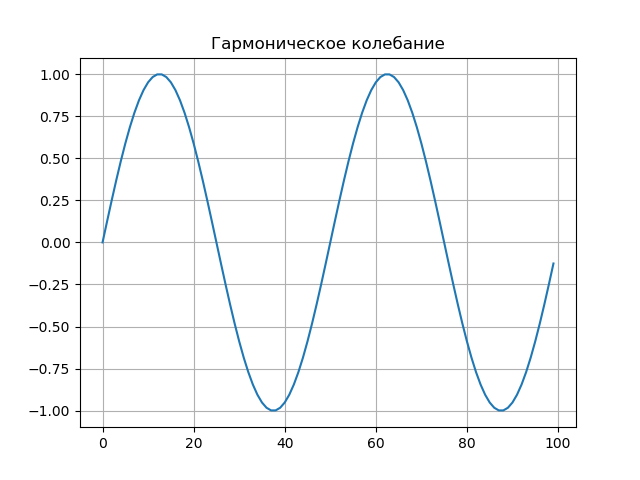
Signal graph.

Graph of a two-parameter spectrum

It should be noted that the section W (a, b) for the time scale
The sum of two harmonic oscillations.
The signal has the form:
Where:
Program listing
from scipy.integrate import quad
from numpy import*
import matplotlib.pyplot as plt
from mpl_toolkits.mplot3d import Axes3D
from matplotlib import cm
N=256
def S(t):
return sin(2*pi*t/10)+sin(2*pi*t/50)
plt.figure(' Сумма двух гармонических колебаний')
plt.title(' Сумма двух гармонических колебаний', size=12)
y=[S(t) for t in arange(0,250,1)]
x=[t for t in arange(0,250,1)]
plt.plot(x,y)
plt.grid()
def w(a,b):
f = lambda t :(1/a**0.5)*exp(-0.5*((t-b)/a)**2)* (((t-b)/a)**2-1)*S(t)
r= quad(f, -N, N)
return round(r[0],3)
x = arange(1,50,1)
y = arange(1,50,1)
z = array([w(i,j) for j in y for i in x])
X, Y = meshgrid(x, y)
Z = z.reshape(49, 49)
fig = plt.figure("Вейвлет-спектр:2-х гармонических колебаний")
ax = Axes3D(fig)
ax.plot_surface(X, Y, Z, rstride=1, cstride=1, cmap=cm.jet)
ax.set_xlabel(' Масштаб:a')
ax.set_ylabel('Задержка: b')
ax.set_zlabel('Амплитуда ВП: $ N_{ab}$')
plt.figure("2D-график для z = w (a,b)")
plt.title('Плоскость ab с цветовыми областями ВП', size=12)
plt.contourf(X, Y, Z, 100)
plt.figure()
q=[w(2,i) for i in y]
p=[i for i in y]
plt.plot(p,q,label='w(2,b)')
q=[w(15,i) for i in y]
plt.plot(p,q,label='w(15,b)')
q=[w(30,i) for i in y]
plt.plot(p,q,label='w(30,b)')
plt.legend(loc='best')
plt.grid(True)
plt.figure()
q=[w(i,13) for i in x]
p=[i for i in x]
plt.plot(p,q,label='w(a,13)')
q=[w(i,17) for i in x]
plt.plot(p,q,label='w(a,17)')
plt.legend(loc='best')
plt.grid(True)
plt.show()
Signal graph.
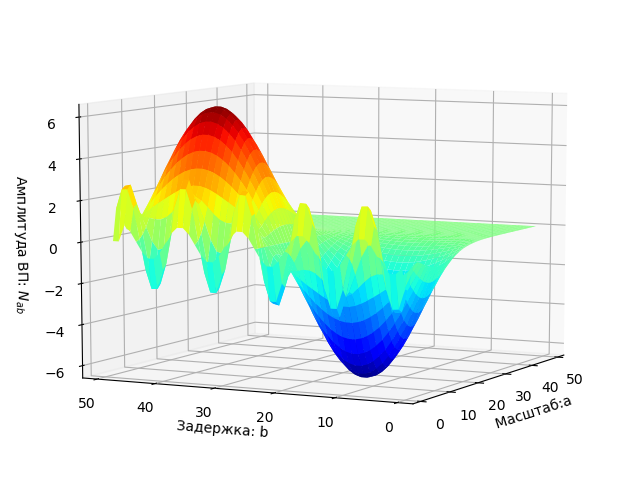
The plot of the two-parameter spectrum W (a, b) is displayed as a surface in three-dimensional space.
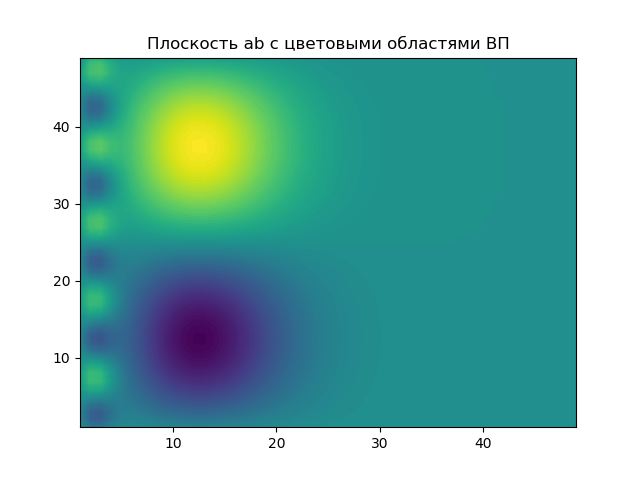
The plane of parameters a, b on which the results of the EP are highlighted in colored areas.

The graph shows the “cross sections” of the wavelet spectrum for two values of the parameter a. With a relatively small parameter of the time scale a, for
As a increases, the extension of the basis function
With a further increase in a, the window band still decreases and the level of this low-frequency component decreases to a constant component (for a> 25), which is equal to zero for the analyzed signal.

The graph shows the cross sections of the wavelet spectrum W (a, b) characterizing the
current signal spectrum for
Rectangular momentum.
Program listing
from scipy.integrate import quad
from numpy import*
import matplotlib.pyplot as plt
from mpl_toolkits.mplot3d import Axes3D
from matplotlib import cm
N=256
def S(t):
U=5;t0=20;tau=60
if t0<=t<=t0+tau:
return U
else:
return 0
plt.figure()
plt.title('Прямоугольный импульс', size=12)
y=[S(t) for t in arange(0,120,1)]
x=[t for t in arange(0,120,1)]
plt.plot(x,y)
plt.grid()
def w(a,b):
f = lambda t :(1/a**0.5)*exp(-0.5*((t-b)/a)**2)* (((t-b)/a)**2-1)*S(t)
r= quad(f, -N, N)
return round(r[0],3)
x = arange(1,100,1)
y = arange(1,100,1)
z = array([w(i,j) for j in y for i in x])
X, Y = meshgrid(x, y)
Z = z.reshape(99, 99)
fig = plt.figure("3D-график вейвлет спектрограммы")
ax = Axes3D(fig)
ax.plot_surface(X, Y, Z, rstride=1, cstride=1, cmap=cm.jet)
ax.set_xlabel(' Масштаб:a')
ax.set_ylabel('Задержка: b')
ax.set_zlabel('Амплитуда ВП: $ N_{ab}$')
plt.figure("2D-график для z = w (a,b)")
plt.title('Плоскость ab с цветовыми областями ВП', size=12)
plt.contourf(X, Y, Z,100)
plt.show()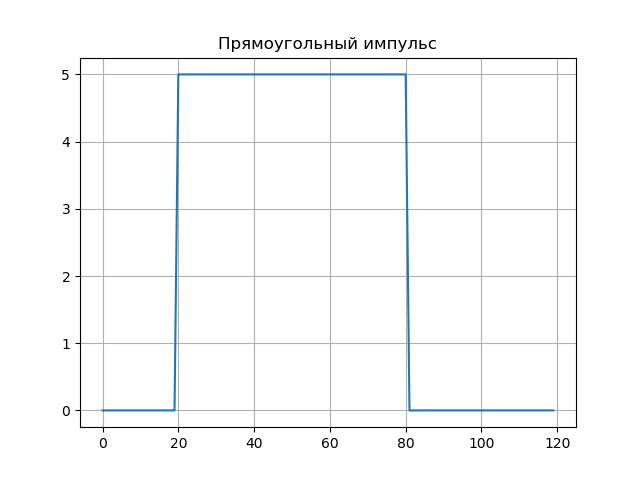


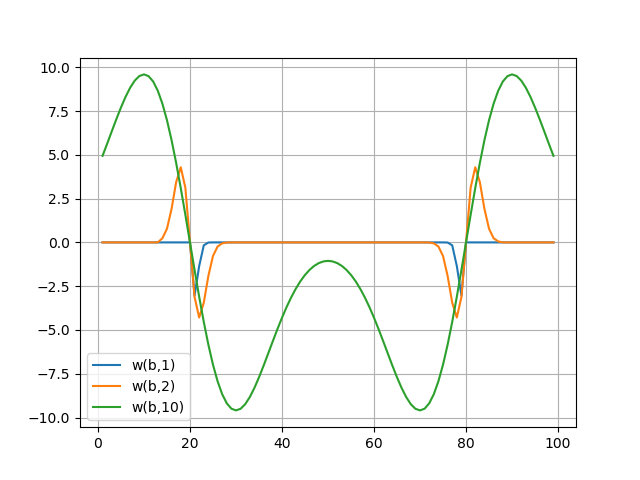
The wavelet spectra are shown in graphs, the wavelet spectrum well conveys the subtle features of the signal - its jumps on the samples b = 20 and b = 80 (for a: 1..10).
conclusions
This publication is educational in nature, it provides basic information about wavelet analysis in general, and simple examples in the freely distributed high-level programming language Python show the features of continuous wavelet analysis with extensive graphical 3D and 2D visualization.
PS The author does not detract from the unconditional advantages of wavelet analysis using Matlab both in terms of the number of wavelets and speed. But in Python there is still room for further development: scipy.signal and PyWavelets.
